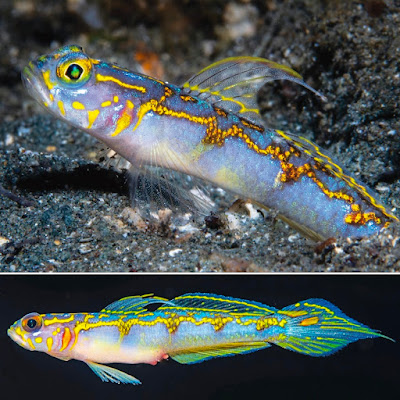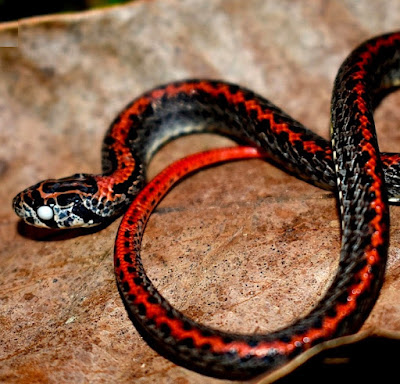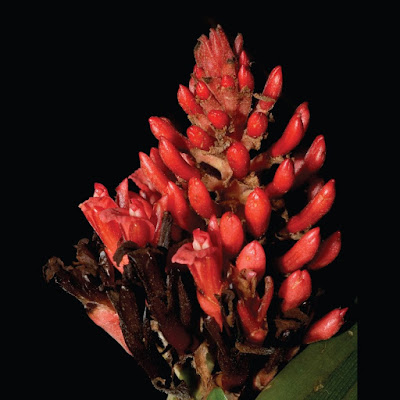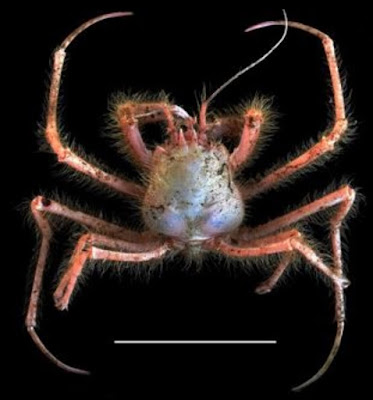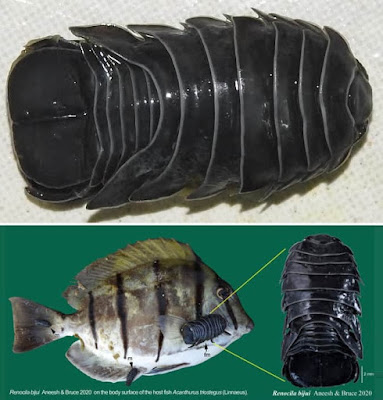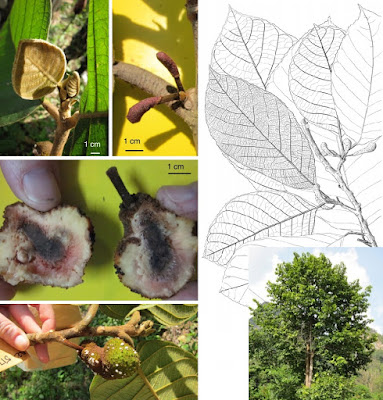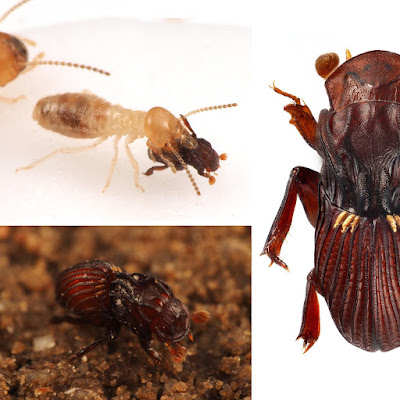[Most Recent Entries] [Calendar View]
Thursday, July 30th, 2020
| Time | Event | ||||||||
| 12:54a | [Ichthyology • 2020] Vanderhorstia vandersteene • A New Species of Shrimpgoby (Pisces: Gobiidae) from Papua New Guinea
Abstract A new species of gobiid fish, Vanderhorstia vandersteene, is described from the East Cape region of Milne Bay Province, Papua New Guinea on the basis of five specimens 17.5-32.2 mm SL. Diagnostic features include dorsal-fin elements VI-I,10-12; the fourth dorsal-fin spine filamentous, reaching the base of about the fifth to seventh segmented dorsal-fin ray when adpressed; anal-fin rays I,11; pectoral-fin rays 16-18; lateral scales 35-37; transverse scales 10; body scales mostly ctenoid, except cycloid scales anterior to the level of about the second-dorsal-fin origin, as well as on the pectoral-fin base, prepelvic region, and the lower side between the pectoral-fins and pelvic fins; scales absent on the head, including medially and anteriorly on the predorsal region; the caudal fin lanceolate with an elongate, median filament; color in life light neon blue with a wavy yellow-orange stripe from the upper operculum to the upper caudal-fin base, prominent yellow-orange bars, bands, and spots on the head and upper sides, a pair of yellow stripes on the second dorsal fin, and yellow streaks and bands on the caudal fin. We include a key to the Vanderhorstia species with low lateral-scale counts (less than 45).
Vanderhorstia vandersteene, n. sp. Electric Shrimpgoby Diagnosis. Dorsal-fin elements VI-I,10–12, fourth dorsal-fin spine filamentous, reaching base of about fifth to seventh segmented dorsal-fin ray when adpressed; anal-fin elements I,11; pectoral-fin rays 16–18; lateral scales 35–37; transverse scales 10; body scales mostly ctenoid, except cycloid scales anterior to level of about second dorsal-fin origin, on pectoral-fin base, prepelvic region, and lower side between pectoral and pelvic fins; scales absent on head, including medially and anteriorly on predorsal region; caudal fin lanceolate with an elongate median filament; color in life light neon blue with wavy yellow-orange stripe from upper operculum to upper caudal-fin base; prominent yellow-orange bars, bands, and spots on head and upper sides; a pair of yellow stripes on second dorsal fin and yellow streaks and bands on caudal fin. Etymology. The new species is named vandersteene, which is treated as a noun in apposition for the combined surnames of Rob Vanderloos and Roger Steene, two highly esteemed underwater photographers who have contributed greatly to our knowledge of the reef fishes of Milne Bay and who have been loyal diving companions over the course of three decades of exploration of the region. It is a pleasure to name this stunning new species in their honor. Distribution and habitat. The new species is currently known only from the type locality, situated on the East Cape Peninsula of Milne Bay Province, Papua New Guinea, about 28 km northeast of the town of Alotau. The habitat consists of a relatively steep outer reef slope with fish occupying burrows on black volcanic sand/ rubble substrates. About 20 individuals were observed in an area that occupied about 600 m2 . Solitary individuals were encountered that were invariably associated with an unidentified snapping shrimp of the genus Alpheus that share the burrows, a symbiotic relationship found in all Vanderhorstia spp. Gerald R. Allen, Mark V. Erdmann and William M. Brooks. 2020. Vanderhorstia vandersteene, A New Species of Shrimpgoby (Pisces: Gobiidae) from Papua New Guinea. Journal of the Ocean Science Foundation. 35, 65-75. DOI: 10.5281/zenodo.3959464 | ||||||||
| 1:52a | [Herpetology • 2020] Rediscovery, New Island Record, and Clarification of the Geographic Distribution of Oligodon perkinsi (Taylor, 1925) (Squamata, Colubridae), A poorly Known Endemic Snake from the Palawan Faunal Region of western Philippines
Abstract Snakes of the genus Oligodon Fitzinger, 1826 are rarely observed and infrequently collected in the Philippines. Here we report the rediscovery and first documentation of Oligodon perkinsi (Taylor, 1925) after nearly 60 years. Our observation extends the species distribution to Busuanga, an island located north of Culion (type locality) and on the western side of the archipelago. Keywords: Busuanga, Calamian Islands, range extension, reptiles Christian E. Supsup and Uldarico V. Carestia Jr. 2020. Rediscovery, New Island Record, and Clarification of the Geographic Distribution of Oligodon perkinsi (Taylor, 1925) (Squamata, Colubridae), A poorly Known Endemic Snake from the Palawan Faunal Region of western Philippines. Check List. 16(4): 877-881. DOI: 10.15560/16.4.877 | ||||||||
| 2:01a | [Botany • 2020] Plagiostachys lourdesiae (Zingiberaceae) • A New Species from Mindanao, Philippines
Abstract A new species, Plagiostachys lourdesiae, from Mindanao, Philippines is described here. Plagiostachys escritorii, which also occurs in Mindanao, is the most closely related species. The new species differs from P. escritorii in its petiolate lamina, lax inflorescence, red and strongly curved upward labellum, and globose to subglobose maroon fruit. A colour plate, notes on its distribution, habitat, phenology, conservation status as well as a key to Plagiostachys species in the Philippines are provided. Keywords: non-mucilaginous, Plagiostachys escritorii, vulnerable Plagiostachys lourdesiae Docot sp. nov. Etymology: The specific epithet is chosen in honor of the accomplished scholarly writer and chair Emeritus of Far Eastern University, Dr. Lourdes R. Montinola. She has continued the legacy of her father and founder of FEU, Dr. Nicanor Reyes Sr., in developing quality education in the Philippines as well as dedication in preserving Philippine heritage, culture and arts. Rudolph Valentino A. Docot. 2020. Plagiostachys lourdesiae (Zingiberaceae), A New Species from Mindanao, Philippines. Nordic Journal of Botany. DOI: 10.1111/njb.02806 | ||||||||
| 9:24a | [Crustacea • 2020] Homolodromia rajeevani • A New Species of Deep-water Crab of the Genus Homolodromia A. Milne-Edwards, 1880 (Decapoda: Brachyura: Homolodromiidae) from the northern Indian Ocean
ABSTRACT Homolodromia rajeevani, a new species of deep-water homolodromiid sponge crab, is described from the northern Indian Ocean (Arabian Sea, depth 957 m, and Bay of Bengal, 645 m), and is the first record of the genus from the area. This species resembles the western Indian Ocean species, namely, Homolodromia bouvieri Doflein, 1904, in having 2 terminal spines on the propodi of the last two pereopods, but can be easily distinguished from the latter species by the inflated carapace, simple long setae on carapace and appendages, slender pseudo-rostral spines separated by a U-shaped base, and a slender arched dactylus of cheliped with maximum elevation at proximal part which bears broadly circular depressions with sparse setae. The most diagnostic character is the higher number of spines on the occlusal surfaces of propodal thumbs and dactyli of the pseudochela of the last two pereopods as compared to H. bouvieri. A key for the identification of the species under the genus Homolodromia is also provided. KEYWORDS: Homolodromia, taxonomy, new species, northern Indian Ocean, deep-water
Family Homolodromiidae Alcock, 1899 Genus Homolodromia A. Milne-Edwards, 1880 Homolodromia A. Milne-Edwards, 1880: 32. Type species: Homolodromia paradoxa A. Milne-Edwards, 1880 by monotypy. Homolodromia rajeevani sp. nov. Etymology: The specific epithet rajeevani is in honour of the distinguished scientist and Secretary, Ministry of Earth Sciences, Government of India, Dr. Madhavan Nair Rajeevan who has been the guiding force in the deep-sea research programmes of CMLRE. Vinay P. Padate, Sherine Sonia Cubelio and K. V. Jayachandran. 2020. Description of A New Species of Deep-water Crab of the Genus Homolodromia A. Milne-Edwards, 1880 from the northern Indian Ocean (Crustacea: Decapoda: Brachyura: Homolodromiidae). Marine Biology Research. DOI: 10.1080/17451000.2020.1735641 k | ||||||||
| 9:38a | [Crustacea • 2020] Renocila bijui • A New Species of Renocila Miers, 1880 (Isopoda: Cymothoidae), A Fish Parasitic Isopod from Andaman Island, India
ABSTRACT Renocila bijui sp. nov., parasitizing the coral reef fish Acanthurus triostegus (Linnaeus, 1758) from Andaman Island, India is described and illustrated. Renocila bijui sp. nov., the first definitive record of the genus from India, is characterized by: rectangular body; truncate frons without a ventral posteriorly directed rostrum; antenna longer and narrower than antennula; pereonite 7 posterolateral angle acute, pleon is 0.8 width of pereon; pleotelson broadly truncate, with prominent median longitudinal carina; pereopods 1–3 each with produced process on the posterodistal angle of basis, gradually increasing the length from 1–3; and pereopods 1–3 inferior margins of articles all without a process or lobe, though ischium carinate. A key to the 17 world species of Renocila is provided. Renocila limbata (Schioedte & Meinert, 1884) and R. periophthalma Stebbing, 1900 are not included since both species lack the description for the adult female. KEYWORDS: Renocila, Indian Ocean, fish parasite, Cymothoidae, Indian exclusive economic zone Renocila bijui sp. nov. Panakkool Thamban Aneesh, Niel L. Bruce, Musaliyarakam Nashad, Kinattumkara Bineesh and Abdulla A. Mohamed Hatha. 2020. A New Species of Renocila Miers, 1880 (Crustacea: Isopoda: Cymothoidae), A Fish Parasitic Isopod from Andaman Island, India. Marine Biology Research. DOI: 10.1080/17451000.2020.1761028 | ||||||||
| 10:29a | [Botany • 2020] Artocarpus rubrosoccatus & A. montanus • Two New Species of Artocarpus (Moraceae) from Thailand and Vietnam
Abstract Recent taxonomic work on Artoarpus has revealed two undescribed species from Thailand and Vietnam. Artocarpus rubrosoccatus, endemic to peninsular Thailand, resembles A. lacucha but is distinguished by its deep red clavate staminate inflorescences. Artocarpus montanus is found in the montane regions of southern and central Vietnam, and perhaps also in Thailand. This species resembles the vegetative parts of A. lowii and A. excelsus, but A. montanus differs in its longer syncarp processes and its geographic distribution. The vast majority of Artocarpus species are found in tropical lowlands, and A. montanus, along with A. excelsus, represent the only known members of the genus that are restricted to montane habitats. The provisional conservation assessment of both new species is Near Threatened, because although their known areas of occupancy are restricted, both occur in protected areas. Keywords: Eudicots, Moraceae, Artocarpus, Thailand, Vietnam, crop wild relatives Artocarpus rubrosoccatus E.M. Gardner, A. Chaveerach, and N.J.C. Zerega, sp. nov. Differt ab A. lacucho Roxb. ex Buch.-Ham. inflorescentiis masculis clavatis rubris profundis.—Differs from Artocarpus lacucha Buch.-Ham. ex Roxb. in the deep red clavate staminate inflorescences. Etymology:—The epithet comes from the Latin rubro-(red) and soccus (slipper, antecedent of the English “sock”) and may be loosely translated “red-socked”, referring to the staminate inflorescences that resemble a pair of feet in red socks. Vernacular name:— Ma-hat khang-khok. ?มะหาดคลองสก Artocarpus montanus E.M. Gardner and N.J.C. Zerega, sp. nov. Differt ab A. lowii King et A. excelso F.M. Jarrett syncarpii processis longiis.—Differs from Artocarpus lowii King and A. excelsus F.M. Jarrett in the longer syncarp processes. Etymology:— The epithet reflects the montane habitat of Artocarpus montanus. Elliot M. Gardner, Arunrat Chaveerach, Runglawan Sudmoon and Nyree J.C. Zerega. 2020. Two New Species of Artocarpus (Moraceae) from Thailand and Vietnam. Phytotaxa. 453(3); 265–274. DOI: 10.11646/phytotaxa.453.3.8 | ||||||||
| 10:34a | [Entomology • 2020] Termitotrox icarus • A New Termitophilous Beetle (Coleoptera: Scarabaeidae) from Myanmar with Observations of Carrying Behavior by Host Termites
Abstract A new species of scarab beetle, Termitotrox icarus sp. nov., is described from central Myanmar, being the third representative of the genus Termitotrox Reichensperger, 1915 from the Indo-Chinese Subregion of the Oriental Region. The majority of the type series was collected from the walls of fungus garden chambers built in the nests of the termite Odontotermes proformosanus Ahmad, 1965. Termitotrox icarus sp. nov. can be easily distinguished from the known Termitotrox as it possesses wing-shaped trichomes on the elytra, the more elongate habitus shape in dorsal view, the basomedian section of pronotum not protruding backwards, a pair of distinct costae on the pronotal basomedian section strongly developed, a median costa on anterior pronotal margin strongly developed, the elytral striae narrower than interstriae, the lack of trichomes at the base of elytral sutural stria, and a mid-range body length of 1.5–1.9 mm. The ‘carrying behavior’ by the host termites is reported for the first time for Termitotrox and a strategy for the dispersal of flightless termitophilous scarabs is hypothesized. Key words: Coleoptera, Aphodiinae, Termitotrogini, Blattodea, Termitidae, Macrotermitinae, new species, egg gigantism, phoresy, termite association, Indo-Chinese Subregion, Oriental Region
Termitotrox icarus sp. nov. Diagnosis. This species is similar to T. cupido and T. venusin having wing-shaped trichomes on the elytral base, but it is easily distinguished from these species because of the following combination of characters: a) the more elongate habitus shape in dorsal view, b) the basomedian section of pronotum not protruding backwards, c) a pair of distinct costae on the pronotal basomedian section are strongly developed, d) a median costa on anterior pronotal margin is strongly developed, e) the elytral striae narrower than interstriae, e) the lack of trichomes at the base of elytral sutural stria, and f) a size intermediate between the two aforementioned species (1.5–1.9 mm) vs. 1.2 mm in T. cupido and 2.4 mm in T. venus. Etymology. In Greek mythology, Icarus was the son of Daedalus. He is famous for having approached the sun with wings made of feathers and wax, which melted and gradually became smaller, thus eventually causing his falling into the sea. The name refers to the smaller elytral wing-shaped trichomes compared to the other known species of the genus having wing-shaped trichomes (i.e.,Termitotrox cupido and T. venus). Noun in apposition. Symbiotic host. Odontotermes proformosanus Ahmad, 1965 (identifi ed by Dr. Yoko Takematsu). Remarks. In some female specimens, we observed a single giant egg (Figs 21 and 22). We randomly chose 20 females and dissected them, 17 of them had one single egg while the others did not bear any egg.
Behavioral observations. In laboratory-based observations, we recorded multiple instances of host termite minor workers carrying T. icarus sp. nov. individuals with their mandibles (Figs 18 and 19, and S1). The beetle constantly exposed its antennae and legs and frequently moved its legs. In each instance, the carrying period was about 5 minutes. This behavior was also observed multiple times in the field. However, nutrient exchange (trophallaxis) between the termite and beetle was not observed during either fi eld or laboratory observations. Kakizoe Showtaro, Liang Wei-Ren, Myint Khin Mar and Maruyama Munetoshi. 2020. Termitotrox icarus sp. nov. (Coleoptera: Scarabaeidae): A New Termitophilous Beetle from Myanmar with Observations of Carrying Behavior by Host Termites. Acta Entomologica Musei Nationalis Pragae. 60(2); 427-436. DOI: 10.37520/aemnp.2020.27 |
| << Previous Day |
2020/07/30 [Calendar] |
Next Day >> |
